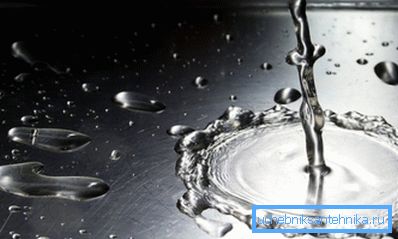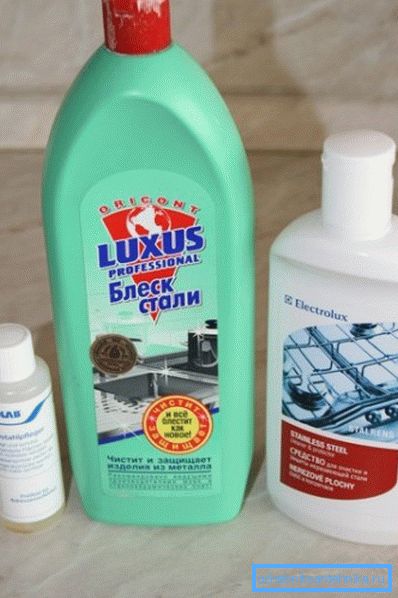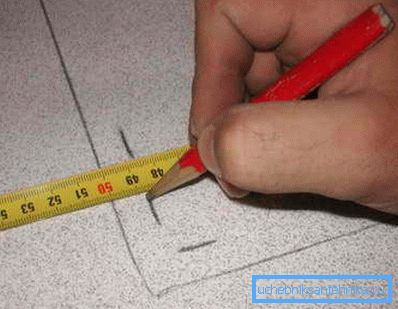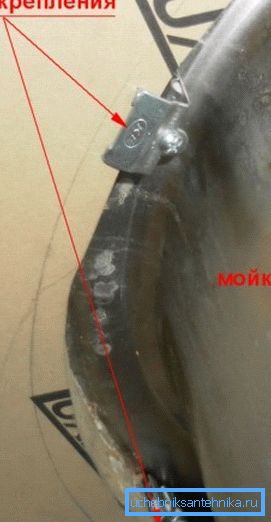Stainless steel sink: features, benefits, installation
Stainless steel sink - one of the most popular types of sanitary ware for kitchens. Due to its low cost and excellent performance, stainless steel washing has become very popular both in our country and abroad.
We will talk about the main features and characteristics of these devices, as well as consider how to install overhead sinks for stainless steel kitchen.

Features and Benefits
Features stainless steel plumbing

The sink for kitchen from a stainless steel possesses a number of features which are inherent in all devices from this material.
For the production of this class of products use a special material - chromic martensitic stainless steel, which has a high corrosion resistance to most weakly aggressive media with sufficiently high mechanical properties.

If we translate the above into a language that is understandable to a wide circle of readers, then we can say that this steel has the following characteristics:
- High resistance to corrosion in conditions of prolonged contact with water, salt solutions, weak solutions of various acids, oxygen in the air, household chemicals, food waste, etc .;
- The material is produced by alloying iron with chromium and a complex of various additives, resulting in a strong and resilient metal. This allows for the production of thin-walled lightweight products that are able to withstand considerable mechanical loads: shock, pressure, bending forces, etc .;
- The significant content of chromium (from 13% and above) allows you to get beautiful shiny or matte surfaces that look great in the interiors of various styles;
- Even continuous contact with water and aggressive solutions for a long time does not lead to corrosion processes and material damage. Due to this, stainless steel products are characterized by a long service life while maintaining the original appearance.
Note! The only weak point of the stainless steel is the fear of abrasive effects: as a result, scratches occur and the shine disappears. Therefore, before cleaning the stainless steel sink, make sure that the tool does not contain abrasive particles.

The most applicable and relevant properties of stainless steel were in the kitchen. The kitchen sink is different in that it is used to wash dishes, which means that it is exposed to the constant effects of household chemicals, food waste, as well as quite noticeable mechanical wear.
Advantages and disadvantages

Steel sinks are most common as kitchen plumbing. This is due to the properties of the material from which they are made, and the characteristics of operation in the kitchen.
Due to the combination of physical and operational characteristics that we have listed, the products have several advantages:
- Lack of corrosion upon contact with cold and hot water, detergents, food debris, solutions of salts and acids;
- The ability for a long time to maintain the original beauty and brilliance. Products are not covered with oxide films, stained, do not darken and do not change color over a long time. With proper care, a steel sink can last more than a dozen years;
- Microorganisms, bacteria, fungal and mold formations do not multiply on the surface of the devices;
- High strength of steel makes it possible not to be afraid of chips, potholes and other mechanical damages, which are typical for ceramics or stone;
- The bowl has thin walls - 0.7 - 5 mm, which makes it very light and easy to install;
- DIY installation is relatively simple and does not require special knowledge and skills;
- The price of products is one of the lowest among the kitchen plumbing.

Note! Steel plumbing is suitable for low-income buyers, as well as for connoisseurs of stylish and high-quality appliances.
Of course, there are disadvantages.
There are not so many of them, however, before buying you need to take into account such moments:
- While washing dishes, the bowl roars loudly enough when water is dropped on its surface, as well as when it comes into contact with metal and ceramic dishes;
- Over time, the surface is inevitably covered with barely noticeable scratches. They do not spoil the look of the product, but they are still visible. Also on the glossy bowls are fingerprints, grease stains and salt deposits from drying water;
- The color range is limited to shades of silver, matte or shiny. There are painted models, but they are much more expensive and not so durable.

Often the question arises: "How to clean the stainless steel sink, so as not to damage and scratch its surface?". Everything is simple here: before you wash a stainless steel sink, you should make sure that there are no grains of sand or other solid particles on its surface.
It is also important to use the right detergents - liquid solutions and gels without abrasive inclusions.
Installation of the invoice model

The models and sizes of stainless steel sinks are presented in a very wide range, so you can easily choose the type that suits your interior.
For self-installation, the type of delivery note is best suited, the installation instructions for which are presented below:
- We turn the sink upside down and lay it on the reverse side of the tabletop. Outline her pencil. Then retreat into the contour of a distance equal to the width of the side of the bowl and draw a line cut;

- We drill the hole so that the cutting line goes tangentially to it, and the hole itself is inside the contour. We insert the jigsaw into the hole and cut a hole in the tabletop. We process the cut with sandpaper and coat with silicone;

- Install the drain base with a siphon connection on the sink (you can immediately screw the siphon), overflow and mixer;

- According to the instructions for the product, install fasteners on the rim of the bowl. The bottom of the side is treated with silicone sealant or mount a rubber seal;

- Insert the bowl into the hole in the tabletop and press down with a small load. Moving under the sink and using a screwdriver, tighten the fastening screws;

- We connect the flexible hoses of the mixer to the water supply system, fasten the siphon and connect it with a corrugation to the sewer hole.

Note! Rubber seals on the hoses is better to miss with special sanitary paste, and threaded connections - to seal with tow or FUM tape.
Conclusion
Sinks made of stainless steel have proven themselves in the kitchen, so they have become very popular and in demand. They are durable, beautiful, easy to install and relatively cheap.
The video in this article will help you to better understand the rules of installation.